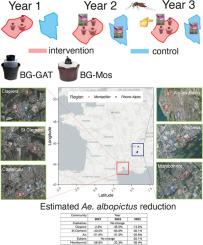在法国进行为期3年的昆虫学聚类随机对照试验,评估大规模诱捕白纹伊蚊控制效果:媒介诱捕器项目
IF 2.5
3区 医学
Q2 PARASITOLOGY
引用次数: 0
摘要
亚洲虎蚊,白纹伊蚊,是一个重大的公共卫生威胁,因为它能够传播登革热和基孔肯雅热等疾病。由于蚊虫抗药性和环境问题,传统的以杀虫剂为基础的控制方法越来越无效。这引起了人们对大规模捕集等替代策略的兴趣,尽管它在减少Ae方面很有效。社区层面的白纹伊蚊种群数量尚不清楚。本研究采用聚类随机对照试验(CRCT)设计,旨在评估在法国六个城市周边社区开展的为期三年的大规模诱捕干预措施。干预前两年采用被动产卵和寻找寄主诱捕与灭源灭幼虫相结合的方法。在第三年,控制转向以社区为基础的方法,由居民维护陷阱和管理繁殖地点。在一些社区,大规模诱捕使蚊子数量减少了36% - 64%,但效果因当地条件、诱捕器密度和实施差异而有所不同。捕集器密度和房屋覆盖率高时,减少幅度最大。第三年显示了在维持社区参与方面的挑战,影响了整体效率。这项研究为大规模捕获的实际应用提供了有价值的见解,强调了适应当地情况的量身定制方法的必要性。本文章由计算机程序翻译,如有差异,请以英文原文为准。

A 3-year entomological cluster randomised controlled trial to assess the efficacy of mass-trapping for Aedes albopictus control in France: The vectrap project
The Asian tiger mosquito, Aedes albopictus, is a significant public health threat due to its ability to spread diseases such as dengue and chikungunya. Traditional insecticide-based control methods are increasingly ineffective due to mosquito resistance and environmental concerns. This has driven interest in alternative strategies like mass trapping, although its effectiveness in reducing Ae. albopictus populations at the community level remains unclear. This study aimed to evaluate a mass trapping intervention over three years in six peri‑urban communities in France, using a Cluster Randomized Controlled Trial (CRCT) design. The intervention combined passive oviposition and host-seeking traps with source reduction and larviciding in the first two years. In the third year, control shifted to a community-based approach, with residents maintaining traps and managing breeding sites.
Mass trapping reduced mosquito abundance by 36–64 % in some communities, though efficacy varied due to local conditions, trap density, and implementation differences. The highest reductions occurred with high trap density and house coverage. The third year revealed challenges in sustaining community participation, impacting overall effectiveness.
This study provides valuable insights into the practical application of mass trapping, emphasizing the need for tailored approaches adapted to local contexts.
求助全文
通过发布文献求助,成功后即可免费获取论文全文。
去求助
来源期刊

Acta tropica
医学-寄生虫学
CiteScore
5.40
自引率
11.10%
发文量
383
审稿时长
37 days
期刊介绍:
Acta Tropica, is an international journal on infectious diseases that covers public health sciences and biomedical research with particular emphasis on topics relevant to human and animal health in the tropics and the subtropics.
 求助内容:
求助内容: 应助结果提醒方式:
应助结果提醒方式:


